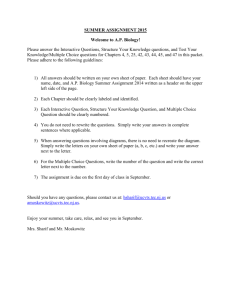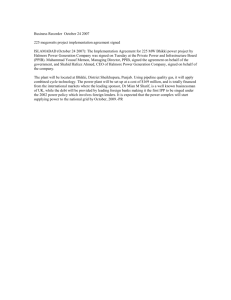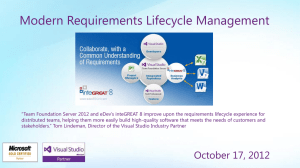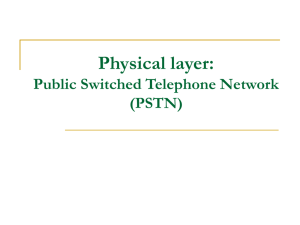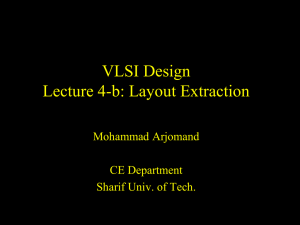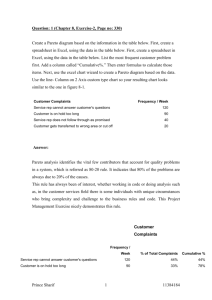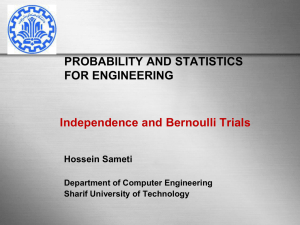2. Network Design - Department of Computer Engineering
advertisement
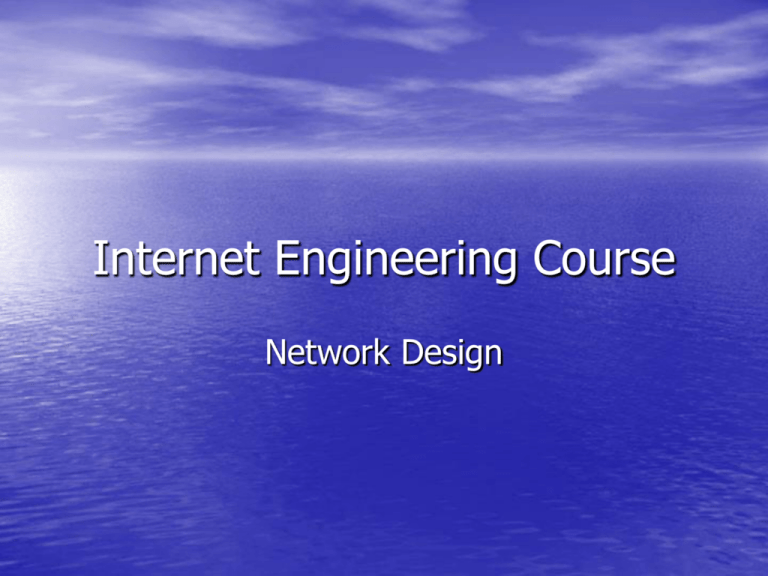
Internet Engineering Course Network Design Contents • Define and analyse an organization network requirements • Discuss about the appropriate solutions – Identify important factors in network design – Find appropriate structure Internet Engineering Course; Sharif University of Technology Design considerations • Budget • Nature of applications • Availability of expertise • Fault tolerance in terms of applications, system and network access • Ease of configuration • Management Internet Engineering Course; Sharif University of Technology Small sized Network (<80 users) • Low budget for IT expense • Little expertise in various technologies • Mostly off the shelf applications – Low bandwidth consumption • Mostly basic requirements, such as email, word • processing, printing and file sharing One or two administrators – Responsible for every aspects of network (generalist) – Server management, backup tasks, connecting new devices, installation of workstations and troubleshooting PC problems Internet Engineering Course; Sharif University of Technology Requirements for SSN • Low cost equipment • Shared bandwidth for most users, switched for a • • • • • selective few A central switch acting as a backbone Flat network design Little fault tolerance Minimal management required High growth provisioning of 20-50% Internet Engineering Course; Sharif University of Technology A sample firm • Connect 50 users to a network • Connect 10 printers to the network • Connect the company’s database and internal e• • • mail services to the network, hosted in a windows NT server Users require connectivity to the internet Several system require access to external email, the Web and FTP connectivity A future web site may be implemented Internet Engineering Course; Sharif University of Technology Connectivity design • The aim is to have a design that is both cost • • • • effective and provisioned for future expansion There is a server room with all the connecting devices and servers The printers are fitted with built in Ethernet ports distributed in the building There are two groups of users, power users group and non power users Power group need to print a lot of documentation, take large documents from server or save presentation files into the server Internet Engineering Course; Sharif University of Technology Connectivity design (cont.) • Non power users do more manual tasks such as answering phone calls • They use the network mainly for reading emails and do some simple word processing • They use low-end PCs Internet Engineering Course; Sharif University of Technology Physical diagram Internet Engineering Course; Sharif University of Technology Physical diagram – expansion plan Internet Engineering Course; Sharif University of Technology Logical network design Internet Engineering Course; Sharif University of Technology Network management • Because of tight budget it is hard to have a dedicated network management workstation • The simplest way is to select switch and hub devices that have web interface Internet Engineering Course; Sharif University of Technology Addressing and Naming • For this size of network a Class C address should • • be used. A private Class C address is used: 192.168.1.0 to 192.168.1.255 Dynamic or Static IP assignment? – It might be hard and maintain a DHCP server – Therefore for small sized network we may decide to use static IPs. • How about a DNS server? – Again setting and maintaining a DNS for this size of network may not be beneficial – Therefore a simple naming scheme maybe used Internet Engineering Course; Sharif University of Technology Connecting the network to the Internet • In the design we used private IP addresses: – Computers can’t use Internet directly, there is a need for NAT functionality – There exists the advantage of security of network • It is decided to use a router with built-in NAT • • functionality It is not cost effective to host email and Web service inside the organization Therefore such servers are outsourced Internet Engineering Course; Sharif University of Technology Medium sized Network (<500 users) • Fixed annual budget for IT expenditure • MIS department taking care of the information • • • • system Develop own in-house applications Availability of one or a few dedicated network engineers Invest in server/host fault tolerance features May provide dial-in service to mobile workers Internet Engineering Course; Sharif University of Technology A sample firm • Connecting 300 users to a network • The company has a AS/400 host and 8 Windows • NT file servers There are 6 departments in the company, each with its own applications: – Marketing – mainly email with external customers, calendaring, word processing, presentation applications – Customer support – mainly handling customer queries, accessing the host for in-house developed applications – MIS – development of applications on AS/400 – Human Resources – Mainly word processing – Engineering – make use of CAD/CAM workstations Internet Engineering Course; Sharif University of Technology Connectivity design • Power users, such as the Engineering department, will • • • • have 100 Mbps switched connections to the desktop Because Marketing users deal with graphics presentation, they will be connected to the 10 Mbps switch in a ratio of 16 users to a switch. Since Customer Support and Human Resources users require fewer computing resources, they are connected to the 10 Mbps switch in a ratio of 24 to a switch. Except for the server in the Engineering department, all the servers are connected to the backbone switch at 100 Mbps. The engineering server is connected to the switch in the Engineering department at 100 Mbps. Internet Engineering Course; Sharif University of Technology Physical diagram Internet Engineering Course; Sharif University of Technology Logical network design Internet Engineering Course; Sharif University of Technology Logical network design (cont.) • With a network of this size it is beneficial to have a DHCP server • Also it is better to have a DNS for name resolution: Internet Engineering Course; Sharif University of Technology Remote access • 15 dial-in users • 8 maximum concurrent dial-in connections • A dial-back service will be implemented. That is, • a remote user initiates a call to the router and triggers the router to dial back to the user. Remote users have to authenticate themselves through a login ID and a password. Internet Engineering Course; Sharif University of Technology Addressing and Naming • There is a requirement for three public • • • addresses to be obtained from the organization’s ISP. These would be for the organizational firewall, the services server hosting FTP, HTTP and e-mail services, the primary DNS server. All these servers should have their IP addresses assigned statically. Organizational domain name must be registered To reduce WAN traffic, the primary DNS server may be placed on the ISP site. Internet Engineering Course; Sharif University of Technology Large size network (>500 users) • Internetwork of networks, with a mix of technologies such as • • • • • • • Ethernet, token-ring, FDDI and ATM. Involves multiprotocol such as TCP/IP, IPX, SNA or NetBIOS. Fault tolerance features for mission-critical applications, such as hardware redundancies, network path redundancies and extensive investment on backup services. Fairly large MIS department to take care of the information system In-house application development teams that constantly look at the deployment of new Internet technologies such as Java and multimedia applications. Availability of experts in areas such as system management, network infrastructure and management. Substantial amount of company’s annual budget is spent on IT investment. Internet Engineering Course; Sharif University of Technology Physical diagram Internet Engineering Course; Sharif University of Technology CE site physical design Internet Engineering Course; Sharif University of Technology Reference • IP Network Design Guide, Martin W. Murhammer, Kok-Keong Lee, Payam Motallebi, Paolo Borghi, Karl Wozabal Internet Engineering Course; Sharif University of Technology
